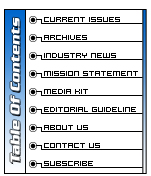|
Airborne: Digital Terrain Models from Radar
By Bob Ryerson Radar Interferometry. The name conjures esoteric research with dubious application to the real world. Not true: Developments in this field are among the most exciting to come along in mapping since the concept of parallax was first used to generate topographic maps from air photos.
Quite simply, radar interferometry uses the differences in radar signals derived from two antennas on the same aircraft to generate not only high resolution images but also measurements of terrain height. By marrying modern radar, digital signal processing, and differential GPS technologies, Canada Centre for Remote Sensing has created one of the first systems for operational mapping independent of solar illumination.
Dr. Laurence Gray developed and first flew the CCRS system in 1991 and comments, "The exciting thing about interferometry is what you don't need. There's no waiting for weather; no need for tedious manual or computer image correlation [image correlation is automatic with interferometry], and, with modern GPS data, a minimal reliance on measurement of ground control points."
Recently, the CCRS Convair 580 radar equipped aircraft returned to Ottawa after a western Canadian mission with Dr. Gray on board. Figures 1-3 illustrate some results processed after the plane's return.
According to Dr. Gray, "The results are great. We have generated radar imagery and associated height data over very difficult mountainous terrain and shown that it can be done efficiently."
"We do have a problem with trees in this area," Dr. Gray said. "The radar waves do not penetrate through the trees to the ground so we sense a height close to the top of the canopy. Therefore, when we subtract our data from the best digital elevation data available, our results don't look so good, but we do get information on the tree height."
For one area without trees the rms error is just 1.5 meters. In treed areas the errors are higher - around 5 meters. Dr. Bryan Mercer, manager of the radar mapping program at Intera, has been interested and supportive of the CCRS development since it's inception. "We see a bright future for this technology and believe Intera is in a very strong position to lead the commercial marketing of interferometric radar mapping as we have done with stereo radar mapping."
Dr. Mercer also believes that the interferometric data processing can be streamlined in a way that more traditional optical or radar stereo techniques can't. "We are pleased with the partnership we are forging with CCRS and look forward to being the first company to operationally market radar mapping using interferometry," Dr. Mercer said. About the Author:
Dr. Bob Ryerson is chief, Industrial Cooperation at the Canada Centre for Remote Sensing in Ottawa, Ontario. He may be reached at 613-947-1214.
Back
|

